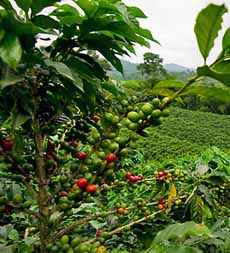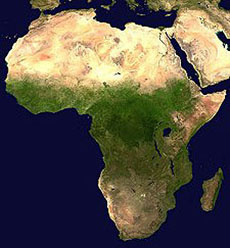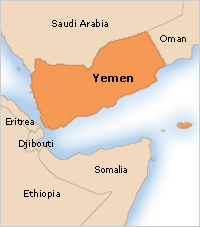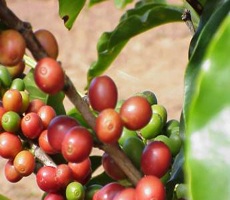

A coffee plantation or farm, with a close-up of the berries ripening on the trees. Coffee is made from the seeds inside the berries (see photo at bottom; this photo courtesy Fair Trade USA).
October 2005
Last Updated September 2018
|
 |
The History of Coffee
Page 1: Born On A Plateau In Africa
CAPSULE REPORT: Born in Africa, coffee is now grown around the word. Coffee is the roasted seed of the fruit, called the cherry, of trees of the genus Coffea of the family Rubiaceae. Arabian coffee is classified as Coffea Arabica, Robusta coffee as Coffea Canephora, and Liberian coffee as Coffea Liberica. Two-thirds of the world’s production is Arabica, Liberica makes up a tiny portion, and Robusta is the difference. Almost all of the coffee we drink is Arabica, but within that species, there are hundreds of different subspecies and blends. As much as we love coffee, it is relatively new in the history of the world. Unlike tea, which is thousands of years old, modern coffee was “invented” only in the 15th century, and was confined to Arabia until the 16th century. This is Page 1 of a three-page article. Click on the black links to visit other pages.
From the Central Plateaus of Ethiopia To Yemen
The story of how coffee growing and drinking spread around the world is starts in the Horn of Africa, on the plateaus of central Ethiopia, several thousand feet above sea level, where the coffee tree probably originated in the province of Kaffa.
There are various fanciful but unlikely stories surrounding the discovery of the properties of coffee.
One story has it that an Ethiopian goatherd named Kaldi was amazed at the lively behavior of his goats after chewing red coffee berries.
Kaldi or not, people who ate the seeds of the berries recognized that they gave energy and alertness.
|
|

MAP: The “horn” of Africa, shown at the right center of the map, consists of Somalia along the cost, and Ethiopia inland. It juts out into the Gulf of Aden (north side) and the Indian Ocean (south side). The long body of water north of the horn, the Red Sea, separates Africa from the Arabian Peninsula. |
Excavations in the Ethiopian highlands where coffee grows wild indicates that humans have been eating the sweet coffee berries for thousands of years. Man has been observed chewing the coffee berries for centuries in Ethiopia and Yemen. Ugandans were noticed chewing dried coffee berries by the first European explorers searching for the source of the Nile. Green coffee beans were ground up and mixed with fat, then made into small balls, good for long journeys.
Exactly where and when coffee was first cultivated is not known. Ethiopia invaded Southern Arabia in 525 A.D.
Many speculate that coffee could have been introduced to Arabia at this time. Other authorities say that around the year 575, Arab traders took it to the southern tip of the Arabian peninsula, now known as Yemen, where the cultivation of coffee began.
Some authorities believe that it was grown initially in Arabia near the Red Sea around the year 675.
What we know with more certainty is that the succulent outer berry flesh was eaten by slaves taken from present-day Sudan into Yemen and Arabia, through the great port of its day, Moka—which gave its name to the coffee later exported from there.
|
|

MAP: It’s easy to see how coffee would have been traded between Ethiopia and Yemen, at the south of the Arabian peninsula. |
Coffee was certainly being cultivated in Yemen by the 15th century, though probably much earlier than that.
Initially, coffee was brewed from green, unroasted beans to yield a tea-like beverage.
Continue To Page 2: Modern Coffee Is Invented
Go To The Article Index Above
|
 |
Coffee berries or “cherries,” as the ripe
berries are called,
growing on the bush. The seeds inside, when roasted, become coffee beans.
Photo by
Ana Labate | SXC.
|
Lifestyle Direct, Inc. All rights reserved. Images are the copyright of their individual owners.

|







